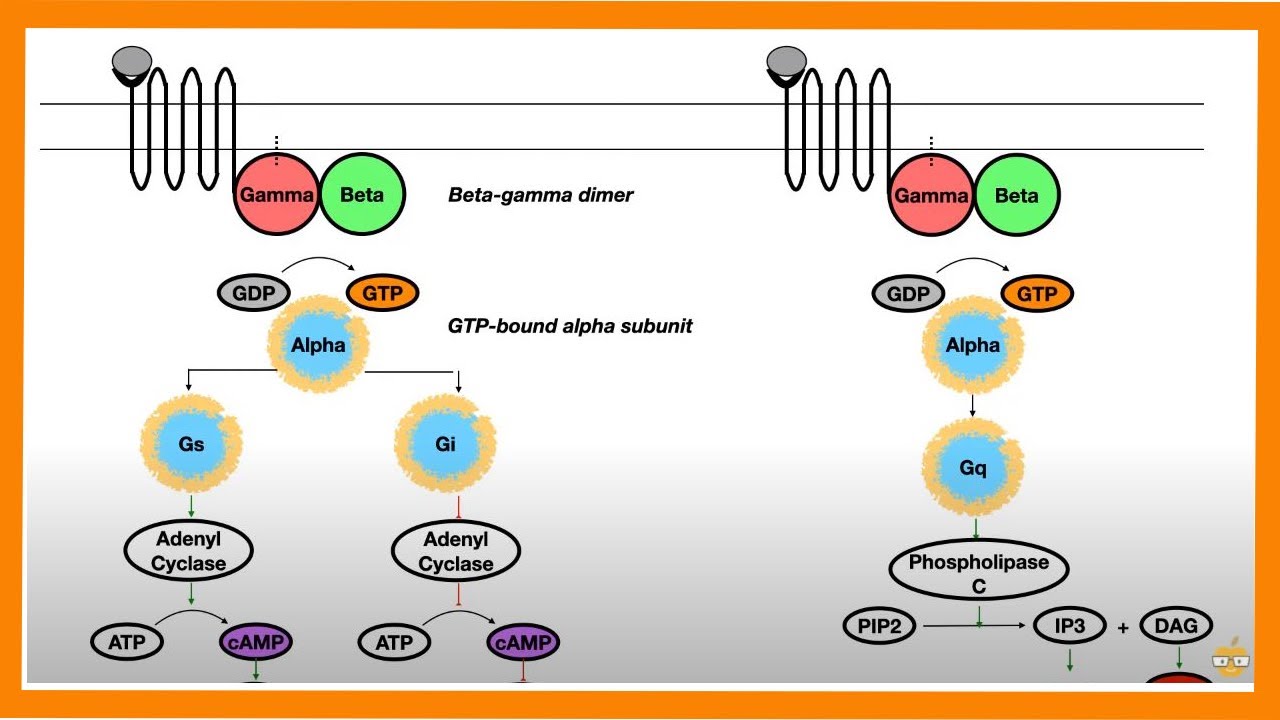G-Protein & G-Protein-Coupled Receptors (GPCR) | Cell Surface Receptor | Physiology | Endocrinology
Summary
TLDRIn this educational video, the host delves into the fascinating world of endocrinology, focusing on cell signal transduction and the pivotal role of G-proteins. The discussion highlights the differences between lipid-soluble and water-soluble hormones, explaining how the latter must interact with cell surface receptors due to their inability to penetrate the lipid cell membrane. The video simplifies complex concepts like G-protein activation, the role of GTP and GDP, and the impact on second messenger systems. It also touches on the physiological significance of these processes, using examples like the sympathetic and parasympathetic nervous systems to illustrate the practical applications of G-protein coupled receptors in medicine.
Takeaways
- 🧬 **Proteins in Cell Signaling**: Almost all active particles in the body are proteins, including channels, pumps, carriers, enzymes, and receptors.
- 🌟 **Hormone Classification**: Hormones can be proteins (water-soluble) or fats (lipid-soluble), which affects their mechanism of action and speed.
- 🚪 **Lipid-Soluble Hormones**: These hormones are slower in action because they must diffuse through the lipid cell membrane to reach intracellular receptors.
- 🔗 **Water-Soluble Hormones**: These hormones bind to cell surface receptors and act quickly, flipping a switch to activate cellular responses.
- 🔑 **Role of G Proteins**: G proteins act as middlemen, linking cell surface receptors to intracellular enzymes, especially for water-soluble hormones.
- 🔄 **G Protein Activation**: G proteins switch from GDP to GTP binding upon activation, which triggers a series of cellular responses.
- 🌡️ **G Protein-Coupled Receptors (GPCRs)**: These are the largest family of cell surface receptors and are crucial for signal transduction of water-soluble hormones.
- 🔋 **Second Messenger Systems**: Activated by G proteins, these systems amplify signals and initiate various cellular responses, such as changes in ion channel activity.
- 🛑 **Termination of Signaling**: GTPase activity converts GTP back to GDP, inactivating G proteins and ending the signal transduction process.
- 🧩 **Integration of Signals**: G proteins integrate signals from cell surface receptors to initiate a cascade of events within the cell, leading to physiological responses.
Q & A
What is the primary reason proteins are involved in most active cellular processes?
-Proteins are involved in most active cellular processes because they are capable of being switched on or off, rotating, or undergoing conformational changes, which are essential for their function. This is due to their complex structures, including primary, secondary, and tertiary structures, and post-translational modifications.
How do lipid-soluble hormones differ from water-soluble hormones in terms of their action speed?
-Lipid-soluble hormones are slower in action compared to water-soluble hormones because they need to diffuse through the lipid cell membrane, which is a slow process. In contrast, water-soluble hormones can quickly bind to cell surface receptors and initiate a response without needing to pass through the membrane.
Why are cell surface receptors for water-soluble hormones located outside the cell?
-Cell surface receptors for water-soluble hormones are located outside the cell because these hormones cannot diffuse through the lipid bilayer membrane. The receptors must be on the outside to bind with the water-soluble hormones directly.
What is the role of the G protein in cell signal transduction?
-The G protein acts as a middleman in cell signal transduction for water-soluble hormones. It links the receptor on the outside of the cell with the enzyme on the inside, facilitating the signal transmission across the cell membrane.
What are the three types of G-protein-coupled receptors mentioned in the script?
-The three types of G-protein-coupled receptors mentioned are: 1) G-protein-coupled receptors, 2) Ligand-gated ion channels, and 3) Enzyme-linked receptors.
How does the G protein switch from an inactive to an active state?
-The G protein switches from an inactive to an active state when a water-soluble hormone binds to the receptor. This binding causes a conformational change in the receptor, which then activates the G protein. The G protein then exchanges GDP for GTP, activating the alpha subunit and leading to the dissociation of the beta and gamma subunits.
What is the function of the GTPase enzyme in the context of G protein activity?
-The GTPase enzyme is responsible for breaking down GTP into GDP, which converts the active G protein back into an inactive state. This hydrolysis reaction terminates the activity of the G protein and stops the signal transduction process.
How does the activation of Gq, Gs, or Gi lead to different cellular responses?
-The activation of Gq typically leads to an increase in intracellular calcium levels and contraction of smooth muscles. Gs activation increases cyclic AMP levels, leading to relaxation of smooth muscles and increased cardiac contractility. Gi activation inhibits adenylate cyclase, resulting in decreased cyclic AMP levels and a variety of inhibitory effects on the cell.
What is the significance of the seven transmembrane helices in G-protein-coupled receptors?
-The seven transmembrane helices in G-protein-coupled receptors provide a complex three-dimensional structure that allows the receptor to span the entire thickness of the cell membrane. This structure is crucial for the receptor's ability to bind the ligand on the outside and interact with the G protein on the inside.
How do different G-protein couplings result in different physiological effects?
-Different G-protein couplings result in different physiological effects because they activate different second messenger systems. For example, Gq activation leads to increased calcium levels and muscle contraction, while Gs activation leads to increased cyclic AMP and muscle relaxation. Gi activation typically inhibits these processes, leading to reduced cellular activity.
Outlines

This section is available to paid users only. Please upgrade to access this part.
Upgrade NowMindmap

This section is available to paid users only. Please upgrade to access this part.
Upgrade NowKeywords

This section is available to paid users only. Please upgrade to access this part.
Upgrade NowHighlights

This section is available to paid users only. Please upgrade to access this part.
Upgrade NowTranscripts

This section is available to paid users only. Please upgrade to access this part.
Upgrade NowBrowse More Related Video
5.0 / 5 (0 votes)





